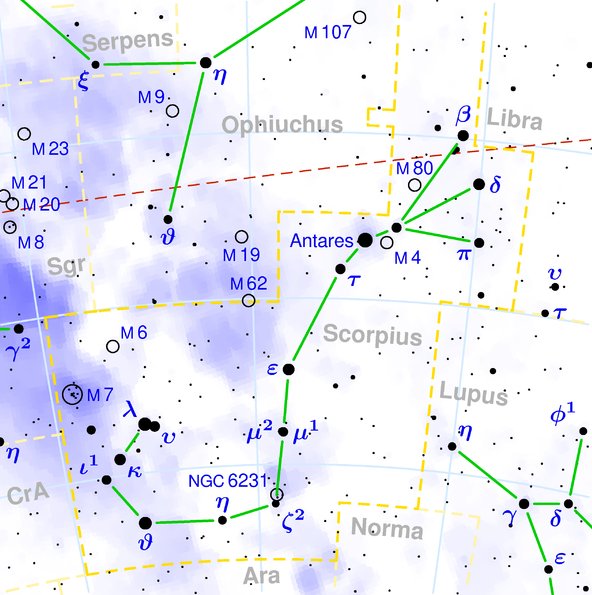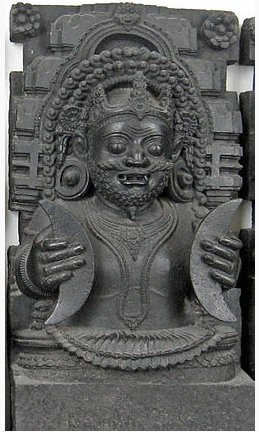1. Allen: "Shaula [λ] probably is from Al Shaulah, the Sting, where it lies; but according to Al Bīrūnī, from Mushālah, Raised, referring to the position of the sting ready to strike. These words have been confused with the names for the adjoining υ, and in the course of time corrupted to Shauka, Alascha, Mosclek, and Shomlek; Chilmead writing of these last: It is also called Schomlek, which Scaliger thinkes is read by transposition of the letters for Mosclek, which signifies the bending of the taile. Naturally it was an unlucky star with astrologers. λ and υ were the 17th manzil Al Shaulah, and the nakshatra Vicritāu, the Two Releasers, perhaps from the Vedic opinion that they brought relief from lingering disease.
Some Hindu authorities, taking in all the stars from ε to υ, called the whole Mūlā, the Root, with the divine Nirrity, Calamity, as regent of the asterism, which was represented as a Lion's Tail; this title appearing also for stars of Sagittarius. "In Hinduism, Nirŗti is the goddess of death and corruption, one of the dikpāla (Guardians of the directions), representing the southwest (or - according Monier-Williamsís Sanskrit-English Dictionary - the south). The name nir-ŗt has the meaning of 'absence of ŗta, lawless'. The masculine form of the name, Nirŗta, is a name of Rudra." (Wikipedia) In Coptic Egypt λ and υ were Minamref, the Sting; and, on the Euphrates, Sarur." Rudra should remind us of Rahu (see Lunar Mansions): ... The presiding deity is Rudra, its symbol is a teardrop, the ruling planet is Rahu ... The deity is Rudra, the God of destruction and it renders this quality in the native. Ardra means moist or wet. It is symbolized as a teardrop. As Rahu is the ruling planet the darker side of keen desire of materialism, causing troubles for others ... In Hindu tradition, Rahu is a cut-off head of an asura, that swallows the sun or the moon causing eclipses. He is depicted in art as a serpent with no body riding a chariot drawn by eight black horses ...
In the Flag of Brazil, which has the same outside perspective as Hevelius and the rongorongo texts, the extremity in the east has 4 + 4 = 8 stars in the Scorpion:
"According to Brazil's national act number 5,700 of 1 September 1971, the flag portrays the stars as they would be seen by an imaginary observer an infinite distance above Rio de Janeiro standing outside the firmament in which the stars are meant to be placed." (Wikipedia) It is necessary to look from the outside when projecting star patterns on the ground. And then, as if by miracle, the constellations in the extreme left of the modern star charts will be projected in the extreme east. |


